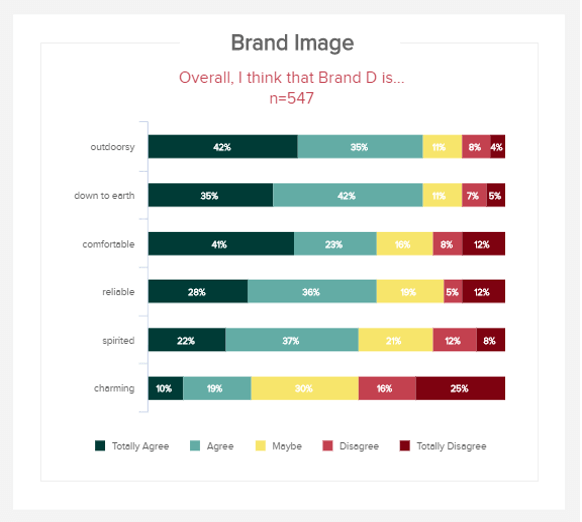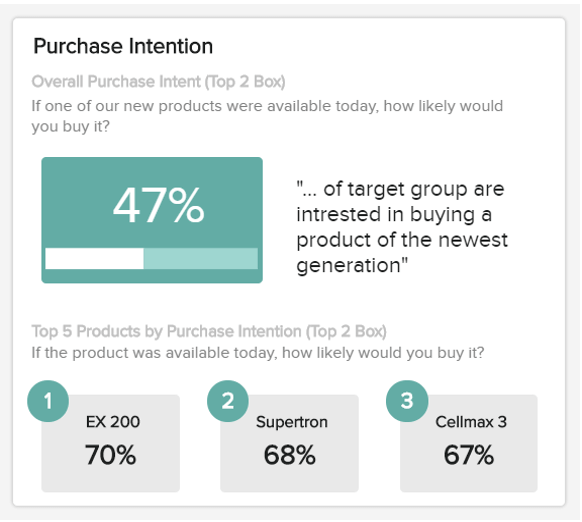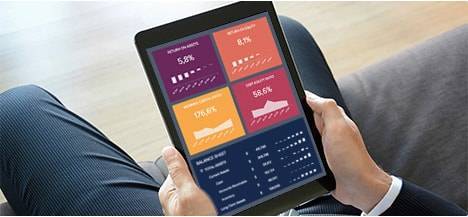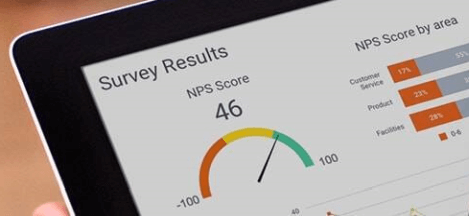
MARKET RESEARCH KPIs
Market Research Key Performance Indicators and Metrics
✔ See different templates & designs ✔ Take your presentation of survey results to the next level
A market research KPI is a performance measurement that is used to monitor, analyze and present survey results in an efficient way. These measurable values cover market research studies concerning product innovation, brand analysis and customer satisfaction etc.
Thanks to professional market research analytics tools and techniques, agencies and businesses can gather quantitative and qualitative data in real-time and visualize it all together in a modern market research report that can be easily automated. Like this, large quantities of consumer data can be summarized and presented in a clear and interactive way. To help you in this quest, we put together a list of critical metrics to help you maximize your research efforts. All these indicators can be carefully put together in an interactive market research dashboard that will help you finding new actionable insights.
Here is the complete list of the most important market research KPIs and metrics, that we will discuss in this article:
Unaided Brand Awareness: Measure the active brand recall
Aided Brand Awareness: Evaluate consumers’ ability to recognize a brand
Brand Image: Find out the impression consumers have of a brand
Celebrity Analysis: See which celebrity is associated with your image
Customer Age Groups: Understand your clients age distribution
Customers By Gender: Track your client’s gender share over time
Customers By Education Level: Learn your target customer’s education level
Customers By Technology Adoption: Discover your consumer’s innovativeness
Usage Intention: Get insights on a new product potential
Purchase Intention: Forecast future customer purchasing behavior
Willingness To Pay: Analyze the price range of a future product
Net Promoter Score: Evaluate customer loyalty and satisfaction
Customer Satisfaction Score: Measure the customer satisfaction
Customer Effort Score: Track the customer experience with a brand

Unaided Brand Awareness
Measure the active brand recallTo evaluate the degree of brand awareness of your company, you can perform surveys over a sample large enough. On our example, we have n=1333 people answering the question “what brands come to your mind when thinking about outdoor products?”. That is a direct, non-aided brand awareness survey that requires active thinking from the people interviewed, who will tell all the names that come to their minds without help. The advantage of open questions is that you don’t get biased answers by presenting specific names straight away. It gives an idea of where each label stands in the mind of people and how visible they are to the average consumer, passionate about the product category the brands stand in or not.
Performance IndicatorsThe most people naming your brand by themselves, the greater the awareness.
Relevant Showcase Dashboard
Aided Brand Awareness
Evaluate consumers’ ability to recognize your brandAfter asking an open question to measure the number of people expressing knowledge of a brand by themselves, comes the aided brand recognition. It is important to ask this question afterwards so as to have the least biased answer on the first one. This KPI asks the surveyed sample if they have heard about well-known brands within a product category (bottled water, cleaning aids, outdoor accessorizes, etc). In this type of survey, the percentages of people knowing a certain label will always be higher than for the previous KPI, as it does not require active thinking from them but recognizing brands among others.
Performance IndicatorsIf people can recognize some brands more than others, it means that they have paid attention to their campaigns.
Relevant Showcase Dashboard
Brand Image
Find out the impression consumers have of a brandThe brand image is the consumer’s perception of a brand, reflected by the adjectives and ideas he or she associates it with. It can be measured using Aaker’s brand dimensions framework. It describes the traits and profile of a brand using five core dimensions that each have several facets. This model is easy to understand and makes an analogy with humans’ personality traits. The five core dimensions that each have several facets are: sincerity, excitement, competence, sophistication and ruggedness. To measure these traits, you can use a five-point Likert scale, from 'totally agree' to 'totally disagree'. On our example aside, we see that the biggest traits of this label are ‘outdoorsy’, ‘comfortable’, and ‘down-to-earth’, that are related to the facet’s ruggedness and sincerity.
Performance IndicatorsAnalyze and compare your brand image with your competitors and evaluate if consumers see your company like you try to present it with your marketing campaigns.
Relevant Showcase Dashboard
Celebrity Analysis
See which celebrity is associated with your imageA pretty easy and straightforward market research KPI is the celebrity analysis. On the same sample of consumers, you only need to ask who, among a list of celebrities you have picked, do they associate with a brand’s name and image. You can also leave it as an open question so as to see who comes first to their mind. It provides you with valuable insights on what type of public figure and personality people affiliate with a company's work. You might have surprising answers, and that can also give food for thoughts on whether their campaigns were rightly made and had the results expected. As a brand, you may then consider partnering with one of the figures that got the higher percentage, if you believe they are in line with your brand image and ethics strategy.
Performance IndicatorsCelebrity endorsement is one of the most popular and efficient tools for advertising when done correctly: it is a good opportunity to use these insights.
Relevant Showcase Dashboard
Customer Age Groups
Understand your customers age distributionMoving on into demographic metrics, we have the customer age groups. This straightforward indicator provides a percentage breakdown of your clients age ranges and it allows companies to segment them in order to provide targeted experiences that will boost loyalty and sales. Once you know your clients age range you can also classify them by generation and have a deeper understanding of their preferences. For instance, Baby Boomers might prefer to buy from physical stores while Millennials, the most targeted and largest demographic group, might prefer online shopping. The age of your target client is increasingly becoming one of the most important demographic metrics. The older your client base, the smaller it will get in time. Therefore, you should always aim at targeting new age ranges with interesting offers and products.
Performance IndicatorsIf you want to enter new markets in other countries or continents, looking at the age range of your client base will allow you to compare them to the ones from the markets you want to enter and define how viable it is.
Relevant Showcase Dashboard
Customers By Gender
Track your client’s gender share over timeNext, we have another demographic metric, this time tracking the share of customers by gender over the past 5 years. Just like with age groups, gender demographics is an important indicator to track as it allows you to understand your clients on a deeper level to provide them with a personalized experience and boost engagement. For instance, a retail store needs to clearly define the way they will market female and male clients. Both groups have different purchasing intentions and resonate to different messaging. In the image above, we can see that the rate of females for this brand grew exponentially in the past years reaching almost 50% in 2022. This means there is a growing interest in this product or service that needs to be looked into.
Performance IndicatorsTake your gender monitoring a bit further and include other diverse groups that don’t fit into the male/female category. This way you ensure you are not leaving any of your clients behind.
Relevant Showcase Dashboard
Customers By Education Level
Learn your target customer’s education levelNext in our list of insightful market research metrics, we have the education level of your clients. Just like our two previous demographic examples, this indicator is very useful to segment your clientele. However, its calculation it’s a bit less straightforward than the others. The education level is a metric that is defined by specific criteria previously imposed by the business. Therefore, it can vary from company to company. The importance of this metric will also vary depending on the industry. While technology companies selling expensive products might need clients with the purchasing power to buy them, other companies selling cheaper products might be more interested in other demographic insights such as gender or age.
Performance IndicatorsTracking this metric over time can tell you how the education level of your clientele has evolved and adapt your strategies accordingly.
Relevant Showcase Dashboard
Customers By Tech Adoption
Discover your client’s innovativenessOur next metric tracks the rate of clients by technology adoption group. The technology adoption cycle is a segmentation technique that groups users into different categories depending on their willingness to adopt innovative technologies. At the top of the list, we have the innovators, being the ones most eager to try new technologies. On the bottom we have the laggards, being the ones more reluctant to change. This indicator is especially useful for companies selling technological goods such as smartphones, computes, camaras, among others, as they need to rely in their client’s innovativeness to buy their products. That said, it is important to monitor this indicator over time as it can tell you if your strategies to attract innovative people have paid off.
Performance IndicatorsThe technology adoption KPI is also useful when it comes to evaluating new product launches. It provides insights into your client’s behaviors and allows you to provide them with a valuable experience while boosting your revenue streams.
Relevant Showcase Dashboard
Usage Intention
Get insights on a new product potentialThe usage intention is a market research KPI that focuses on a specific type of product and the relationship consumers have with it. It is a metric asking about their intention to use it in place of another similar product but with a different characteristic. On our example aside, the specific characteristic is the novelty of the product: 41% of the target group would rather use a new-generation item than an older one, or than a competitor’s one. Marketers use this metric to estimate potential future purchasing from consumers, but also to get a feedback on a new product or service and the enthusiasm it triggers. If people are eager to use a new product instead of an old or a competitor’s one, it means that it has an added value.
Performance IndicatorsThe more people willing to use it, the better. However, don’t base a whole product development solely on these results.
Relevant Showcase Dashboard
Purchase Intention
Forecast customer future behaviorThis market research metric takes the consumer’s intent a step further, by positioning them in an active state of potentially acquiring a product. It is often used by marketers as an input to make decisions on already-existing and new products or services. They are used to predict future sales, but should not be relied on so much - it remains an intention and does not always translate into future sales. Sales rely on many other external factors you cannot control on the moment of purchase: time, money available, tiredness, product or advisers available in store, long queue at the cashier, etc. On our example aside, 47% of the target group are interested in buying the newest product; and the top new products are then ranked by purchase intention.
Performance IndicatorsThe higher the percentage, the better, as it means that the market responds positively to it. However, don’t take it at face value as many other factors are involved on the purchasing moment.
Relevant Showcase Dashboard
Willingness To Pay (WTP)
Find out the price range of a future productThe willingness to pay (WTP) represents the higher and lower price limits a consumer would pay for a product. It gives you a range on which you can fix the price of a product, and more specifically, the costs that should not be exceeded if you want to make profit on it. It is important when it comes to pricing decisions or a new product development. The scale used for this KPI is inspired by Stoetzel, who would ask customers directly their maximum and minimum price for a product taking into account other aspects like the quality of the product. If it is too low, there might be distrust towards the quality and long-lasting potential of the product.
Performance IndicatorsPush the analysis further by providing a price and evaluating the reaction towards it: is too high, too low, and in which proportions?
Relevant Showcase DashboardBecome a data wizard in less than 1 hour!

Net Promoter Score (NPS)
Evaluate customer loyalty and satisfactionThis is a trans-disciplinary metric that is used in many different departments – and especially important for the customer service. It measures the likelihood of customers to recommend a product or services to their friends and relatives. The question simply asks to grade, from 0 to 10, how likely they would recommend the brand. Their answers should then be classified as follows: 0-6 are detractors, 7-8 are passives, and 9-10 are promoters. You can then evaluate your score by subtracting the percentage of detractors to the percentage of promoters. Set yourself a target you want to reach and measures your NPS on a regular basis to be sure you are not falling back.
Performance IndicatorsNPS highly depends on the industry. Find a benchmark of your competitors' scores and try to exceed them.
Relevant Showcase Dashboard
Customer Satisfaction Score (CSAT)
Measure the satisfaction with a product or serviceStudies show that over 90% of unhappy customers won’t do business with you again: that’s a figure you certainly don’t want to be applied to you. This is why surveying and asking regularly how your customers feel about your products and service is essential to get direct insights and not lose touch with reality. There are many ways to perform such survey, whether by email, live on the phone or at the store, within your company’s app, on your website, etc. Simply asking how satisfied they are, providing a 1-to-5 scale, will already give you a good idea of where you stand. Customers also feel their opinion is valued and taken into account, which plays in your favor.
Performance IndicatorsThe more satisfied, the better of course! This is a score you can show on your website, along client testimonies, as today everyone searches online reviews before engaging with a business.
Relevant Showcase Dashboard
Customer Effort Score (CES)
Measure the customer experience with a brandThe customer effort score (CES) is measuring how fast and simple customers find their interaction with your business. It is very useful to spot any bottlenecks and frictions in the customer experience, and can predict future purchase behavior. You can measure the CES after a specific customer support interaction, after purchases, in meetings, live chats, etc. There are several ways to measure it: as a simple average of the grades given after answering “on a scale from 1 to 10, how much effort did you put to get the help you needed?”, or with a NPS-style approach like on our example aside.
Performance IndicatorsThe lower your score, the better. Reducing frictions and enhancing the customer experience is a must to see them coming back.
Relevant Showcase DashboardSetup only takes a few minutes. No credit card required!























